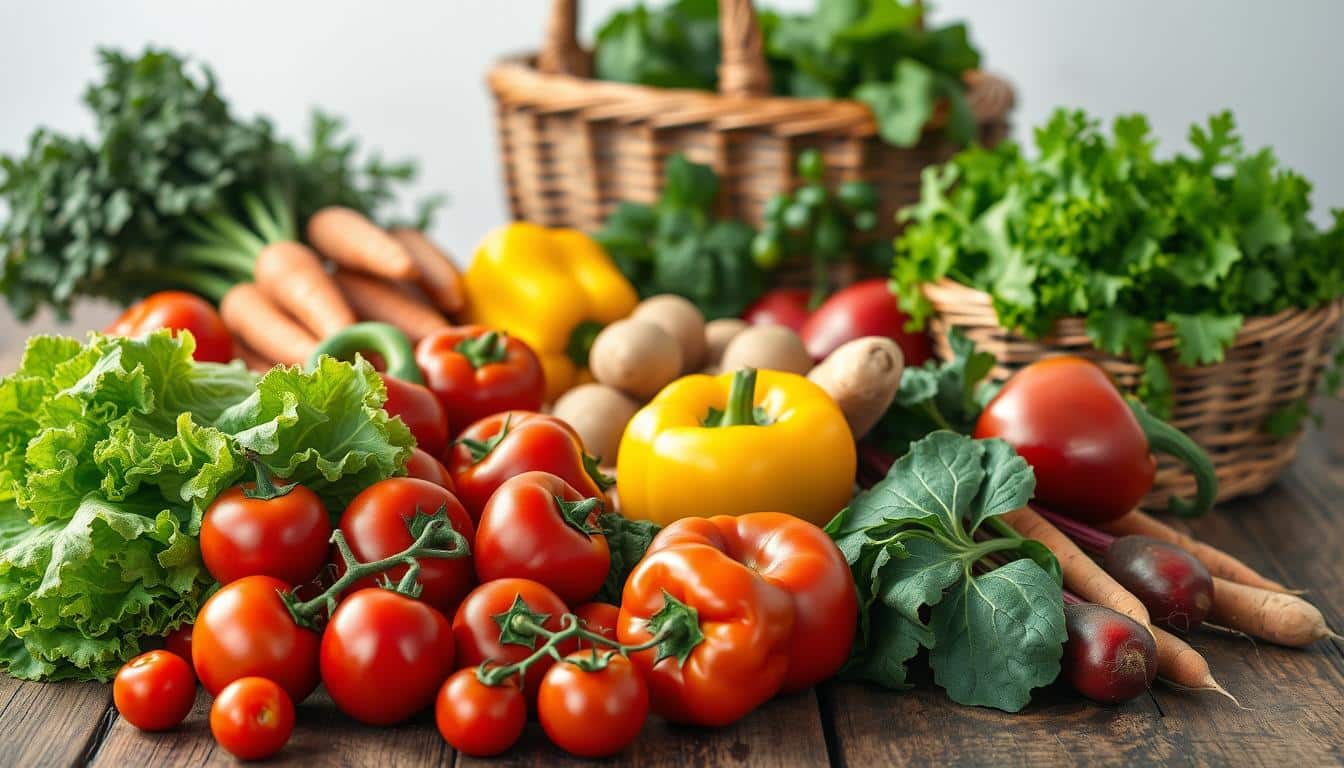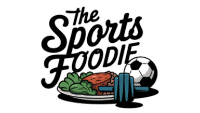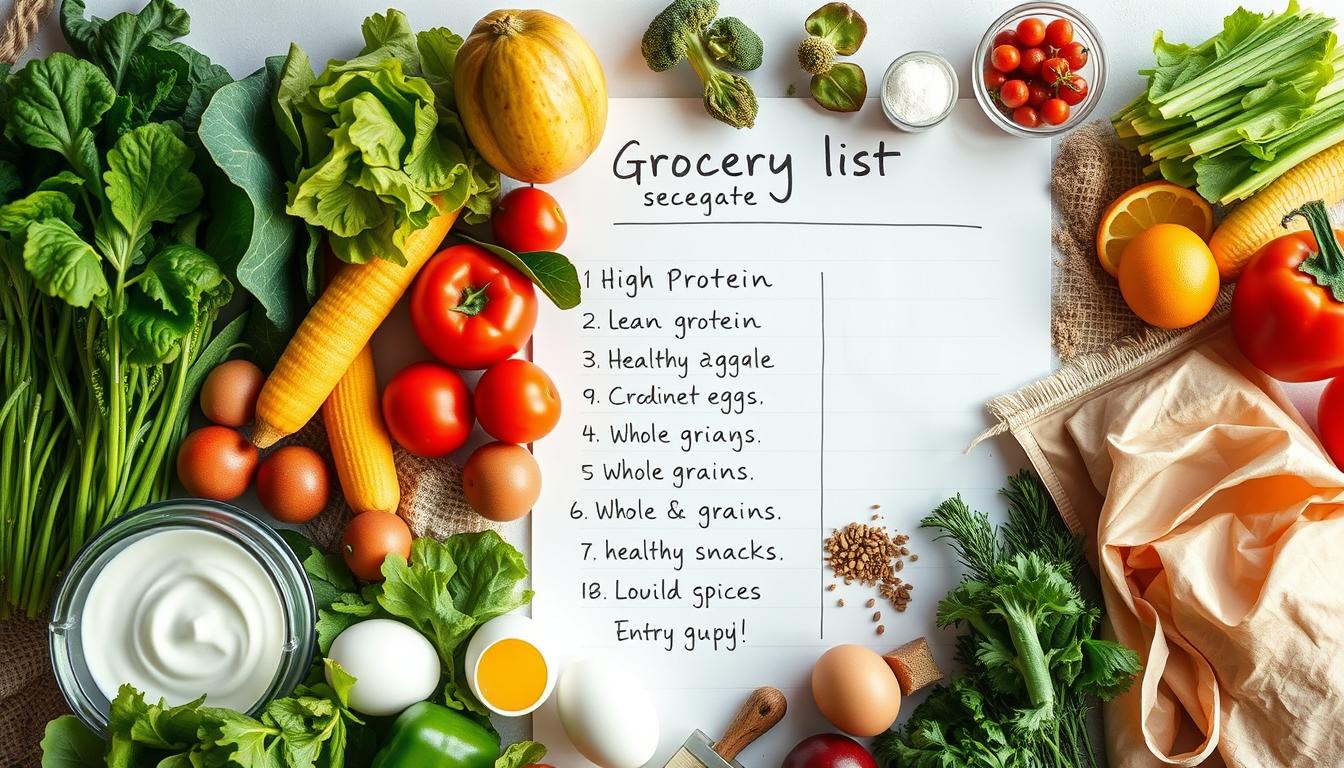Can a simple shopping plan really save you time, keep you fueled, and cut down on waste while you train?
I used to overthink every aisle. Then I found a few smart swaps that stretch a single rotisserie chicken into multiple meals and keep protein steady across the day.
This short plan shows how to shop smarter. You’ll see why big tubs of yogurt and blocks of cheese beat single-serve cups. You’ll learn to pick frozen produce when fresh prices jump and to buy grains and beans in bulk to lower unit cost.
Follow this simple approach and you get fast shopping, less waste, and meals that support recovery. I’ll show apps like Ibotta and Flipp that pay you back while you shop. You’ll save money and still hit protein targets without extra time in the kitchen.
Smart shopping game plan for athletes on a budget
Smart prep before you hit the store saves time and protects your training fuel. Do a quick inventory of fridge, freezer, and pantry first. This cuts duplicate buys and stops spoilage.
Scan weekly flyers with Flipp to compare grocery store sales. Load digital coupons and turn on Ibotta to collect cash back at checkout. Pick store brands on lower shelves to keep quality and save money.

Build a simple weekly plan and stick to the list. Base the list on meals that share ingredients. Choose multi‑use items like rice, beans, chicken thighs, and mixed vegetables.
- Check pantry to cut redundant items and save money.
- Use Flipp to set your weekly plan and spot sales.
- Turn on Ibotta to lower your final bill.
- Buy only foods you’ll eat in the next 5–7 day window to avoid waste.
- Shop at low‑traffic times to move fast and skip impulse buys.
Fresh and frozen produce picks that save money
Choosing in‑season fruits and frozen greens makes meal prep faster and cheaper. You get better taste and more nutrients when you buy what’s ripe or properly frozen.

In‑season and sale stands
Scan the grocery store sale stands first. Look for apples, bananas, carrots, and onions at lower prices.
Pick in‑season produce to get better flavor and a lower price per pound.
Frozen staples that keep nutrients
Frozen berries, spinach, and mixed peppers hold vitamins well. Use frozen options when fresh costs spike.
Portion frozen mixed vegetables for quick skillet recipes and omelets. This saves prep time and reduces waste.
Prep tips to save time
Avoid pre‑cut trays. Batch chop at home and store in clear containers. That makes assembly fast during the week.
- Build meals around vegetables to raise fiber and vitamin intake.
- Use a variety of colors to cover more nutrients and keep plates interesting.
- Add produce to the list first to anchor shopping and control spend.
| Pick | When to buy | Best use |
|---|---|---|
| Apples & Bananas | In‑season / sale stands | Snacks, oats, smoothies |
| Carrots & Onions | Year‑round, often on sale | Roast, stews, quick sides |
| Frozen berries & spinach | When fresh is pricey | Smoothies, sauces, sautés |
| Mixed frozen peppers | Out of season | Skillets, omelets, stir‑fries |
Tip: Treat produce as a good source of micronutrients that support training. Small prep steps save you time and keep recipes ready all week.
Budget proteins that fuel training and recovery
Pick protein items that stretch across several dishes and still hit recovery targets.
Poultry and meat: Grab chicken thighs and turkey for high protein and low cost. A store rotisserie chicken can cover two to three meal portions. Use chuck roast for braises that feed the week.
Seafood values
Canned tuna and canned salmon give affordable omega‑3 and easy portions. Frozen salmon fillets and frozen white fish are solid low‑cost options you can thaw as needed.
Dairy and eggs
Buy large tubs of yogurt and cottage cheese. Choose blocks of cheese instead of pre‑shredded. Eggs stay cheap and versatile across each meal.
Plant proteins
Add beans, lentils, tofu, tempeh, edamame, and high‑protein pasta to widen your protein source mix. These items give variety and support an iron‑rich diet.
- Space intake to ~25–30 g protein per meal to aid recovery.
- Track source diversity so each option brings unique nutrients.
| Item | Typical use | Why buy | Quick tip |
|---|---|---|---|
| Rotisserie chicken | Salads, bowls, sandwiches | Stretches into multiple meals | Shred and freeze portions |
| Canned tuna & salmon | Sandwiches, pasta, salads | Long shelf life, protein & omega‑3 | Mix with yogurt or avocado |
| Chuck roast | Stews, tacos, slow cook | Cheap per pound, tender when braised | Cook low and slow |
| Beans & lentils | Bowls, soups, sides | Plant protein and iron | Cook in bulk and freeze |
Want high‑energy breakfast ideas? See high-energy breakfast ideas to pair with these sources.
Grains and starches to power your day
Stocking smart grains makes it easy to build filling plates in minutes. Pick a handful of versatile staples and you’ll save prep time and cut waste.
Bulk buys and batch cooking
Buy oats and brown rice in bulk from the bin section to lower cost per serving. Large bags stretch across breakfasts, bowls, and snacks.
Cook big batches on Sunday. Portion into containers so a ready meal is minutes away.
Bread, tortillas, and freezing tips
Freeze extra loaves and wraps after slicing. Thaw only what you need to stop waste and save grocery trips.
Starchy veggies that fill you up
Keep potatoes and sweet potatoes on hand as cheap, filling sides. Roast or mash them to pair with any protein.
- Check per‑ounce costs and compare dry bin prices.
- Add fiber‑rich grains to aid digestion and satiety.
- Keep whole grain pasta and quinoa for quick skillet meals.
| Item | Use | Tip |
|---|---|---|
| Oats | Breakfast, bars, smoothies | Buy bulk; makes overnight oats fast |
| Brown rice | Bowls, sides | Cook once, use all week |
| Sweet potato | Roast, mash, fries | Freeze cooked portions |
Healthy fats and omega‑3 sources for athletes
Adding the right fats helps you train harder and recover faster without extra fuss. Fats include oils, fish, nuts, and seeds. Some fats give essential fatty acids — nutrients your body can’t make.
Kitchen staples
Olive oil and avocado oil are versatile. Use one bottle on the counter and keep a backup in the pantry. They cook vegetables and finish bowls with flavor and calories.
Fish and plant options
Salmon and tuna provide omega‑3 fatty acids that help recovery. Plant seeds like flax, chia, and hemp add texture and healthy fat. Rotate fish and plant picks to balance your diet and protein sources.
Spreads and extras
Peanut butter, tahini, and hummus raise calories and satiety at low cost per serving. A spoon on oats or toast makes a meal more filling.
- Add a spoon of seeds to a meal to boost fats with no extra prep.
- Choose sale fish or canned options as an addition to save money.
- Use these foods as a good source of long‑lasting energy on heavy training days.
| Source | Why buy | Quick tip |
|---|---|---|
| Olive / Avocado oil | Cooking & finishing | Keep one bottle out, one stored |
| Salmon / Tuna | Omega‑3 fatty acids | Eat weekly; canned works well |
| Flax, Chia, Hemp, Walnuts | Plant fatty acids & texture | Spoon into yogurt or oats |
Snack ideas that fit a tight budget
Quick, tasty snacks keep your energy steady between workouts without empty calories. Pick things that travel well and need little prep.
Simple picks
Easy choices: popcorn and trail mix last long and cost less than packaged bars. String cheese and fresh fruit are grab-and-go when you’re short on time.
Baby carrots with hummus add crunch and fiber. These items pair with most meals and workouts.
Bars and bites
Bake oat-based bars at home to save money and control ingredients. Roll energy bites with oats, peanut butter, and seeds for quick fuel.
- Pack popcorn or trail mix for shelf-stable energy.
- Grab string cheese and fruit during the day.
- Dip carrots in hummus for a crunchy hit.
- Bake oat bars to cut costs and sugar.
- Roll energy bites with oats, nuts, and seeds.
- Prep snack packs once to save time all week.
| Snack | Prep | Best use |
|---|---|---|
| Popcorn | Air-pop in minutes | Pre-workout or study session |
| Trail mix | Mix nuts, raisins, spices | Long shelf life, travel |
| Oat bars | Bake and cut | Post-workout or mid-day meal |
| Energy bites | Roll, chill | Quick fuel on the go |
Keep a short shopping list of these foods so buying is fast. For more healthy snack ideas, check a helpful guide to teen options: healthy snack ideas.
Freezer wins and convenience items that cut costs
A smart frozen stash frees up your weeknights and removes guesswork from meal prep.
Frozen produce beats fresh produce prices off‑season. You shop the freezer aisle when berries, greens, or mixed vegetables spike in cost.
Grab frozen mixed vegetables to speed up stir‑fries and skillet builds. They save you prep time and reduce waste.
Frozen burger patties — beef, salmon, or plant‑based — give portion control and predictable cost. These options freeze well and thaw fast when you need a quick meal.
- Use rotisserie chicken as a fast base when evenings get busy.
- Watch the grocery store circular for BOGO freezer deals to save money.
- Choose store‑brand frozen items to cut costs without losing quality.
- Cook once, freeze extra portions, and label items with dates to rotate first‑in, first‑out.
| Item | Why it helps | Quick tip |
|---|---|---|
| Frozen fruit & vegetables | Consistent nutrition off‑season | Puree into smoothies or heat as sides |
| Frozen patties | Portions and cost control | Batch cook and freeze singles |
| Pre‑cooked rotisserie chicken | Fast protein base | Shred and add to bowls |
Keep a few ready‑to‑heat items to cover hectic training weeks. These simple things stretch ingredients and cut trips to the store. You save time and money while keeping your plate reliable.
Pantry staples every athlete should stock
A well-stocked pantry keeps dinner simple when training ramps up and time is tight. Keep a short set of reliable items that pull together fast recipes and steady energy.
Canned goods to keep on hand
Stock cans of beans, tomatoes, tuna, pumpkin, corn, and beets. Canned beans are a fast protein and a good source of fiber. Keep a few on the shelf to build bowls, stews, and quick salads.
Breakfast basics that travel
Keep oats, cereal, granola, dates, and raisins ready. These start a quick meal and pair with yogurt or milk. Bulk tubs beat single‑serve and save time on prep.
Flavor builders: make your own
Make DIY stock, simple sauces, and condiments. A jar of homemade sauce stretches across several recipes and lifts canned produce and vegetables.
- Buy grains and lentils from the bins to cut cost per ounce.
- Store staples in clear bins so you see what you have at a glance.
- Write the next grocery list as soon as an item runs low to avoid extra trips.
| Category | Key items | Quick use |
|---|---|---|
| Canned goods | Beans, tomatoes, tuna | Bowls, soups, sandwiches |
| Breakfast | Oats, granola, dried fruit | Overnight oats, quick cereal |
| Flavor | Homemade stock, sauces | Boosts simple pantry recipes |
Pantry meals cover busy nights and cut takeout. With canned beans and bulk grains you capture protein and fiber while keeping costs down.
budget grocery list for athlete meals: sample week of meals
A clear weekly menu takes the guesswork out of shopping and keeps training days simple.
Breakfast ideas
Monday breakfast: overnight oats with banana and chia seeds. This oats option beats cereal per serving and keeps energy steady.
Tuesday breakfast: yogurt with granola and frozen berries to boost protein and fiber. Swap seeds or fruit to add variety.
Lunch ideas
Lunch rotation: brown rice and black beans with peppers, onions, and salsa. Rice + beans form a complete protein and stretch well.
Lunch rotation: chicken wrap with mixed vegetables and hummus for a quick, portable meal.
Dinner ideas
Dinner option: roasted chicken thighs with sheet-pan vegetables. It scales and freezes in portions.
Dinner option: salmon, quinoa, and broccoli using frozen produce to save money and keep nutrients.
Pre‑ and post‑workout
Pre-workout: half peanut butter sandwich and water with a pinch of salt for simple electrolytes.
Post-workout: chocolate milk and pretzels to rehydrate and hit carb‑protein targets fast.
- Swap produce to change flavors while using the same base grains and proteins.
- Add an iron source mid-week via beans or a lean red option to support recovery.
- Use the same recipes across several nights to simplify cooking and eating.
| Day | Breakfast | Lunch | Dinner |
|---|---|---|---|
| Mon | Overnight oats + banana | Rice & black beans | Roasted chicken + vegetables |
| Wed | Yogurt + granola | Chicken wrap | Salmon, quinoa, broccoli |
| Fri | Oats with seeds | Rice bowl with veggies | Leftover roast or simple skillet |
Conclusion
A clear plan turns weekly shopping into a quick, predictable part of your routine.
Careful planning and smart use of sales, apps, and bulk options can save up to $100 a month while keeping nutrient needs high. Spread protein across the day, lean on frozen produce, and buy blocks or tubs instead of single‑serve items to lower cost and waste.
Use this way of shopping and prepping to save time and money. Repeat simple recipes, swap proteins and grains to keep variety, and freeze extras to cut stress.
Keep a living grocery list, watch vitamins with produce and beans, and stay consistent. This is the way to fuel performance and protect your wallet while enjoying better eating and a stronger diet.


